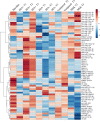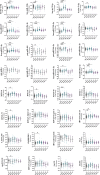Unique diagnostic signatures of concussion in the saliva of male athletes: the Study of Concussion in Rugby Union through MicroRNAs (SCRUM)
- PMID: 33757972
- PMCID: PMC8639909
- DOI: 10.1136/bjsports-2020-103274
Unique diagnostic signatures of concussion in the saliva of male athletes: the Study of Concussion in Rugby Union through MicroRNAs (SCRUM)
Abstract
Objective: To investigate the role of salivary small non-coding RNAs (sncRNAs) in the diagnosis of sport-related concussion.
Methods: Saliva was obtained from male professional players in the top two tiers of England's elite rugby union competition across two seasons (2017-2019). Samples were collected preseason from 1028 players, and during standardised head injury assessments (HIAs) at three time points (in-game, post-game, and 36-48 hours post-game) from 156 of these. Samples were also collected from controls (102 uninjured players and 66 players sustaining a musculoskeletal injury). Diagnostic sncRNAs were identified with next generation sequencing and validated using quantitative PCR in 702 samples. A predictive logistic regression model was built on 2017-2018 data (training dataset) and prospectively validated the following season (test dataset).
Results: The HIA process confirmed concussion in 106 players (HIA+) and excluded this in 50 (HIA-). 32 sncRNAs were significantly differentially expressed across these two groups, with let-7f-5p showing the highest area under the curve (AUC) at 36-48 hours. Additionally, a combined panel of 14 sncRNAs (let-7a-5p, miR-143-3p, miR-103a-3p, miR-34b-3p, RNU6-7, RNU6-45, Snora57, snoU13.120, tRNA18Arg-CCT, U6-168, U6-428, U6-1249, Uco22cjg1,YRNA_255) could differentiate concussed subjects from all other groups, including players who were HIA- and controls, immediately after the game (AUC 0.91, 95% CI 0.81 to 1) and 36-48 hours later (AUC 0.94, 95% CI 0.86 to 1). When prospectively tested, the panel confirmed high predictive accuracy (AUC 0.96, 95% CI 0.92 to 1 post-game and AUC 0.93, 95% CI 0.86 to 1 at 36-48 hours).
Conclusions: SCRUM, a large prospective observational study of non-invasive concussion biomarkers, has identified unique signatures of concussion in saliva of male athletes diagnosed with concussion.
Keywords: brain; concussion; contact sports; diagnosis; trauma.
© Author(s) (or their employer(s)) 2021. Re-use permitted under CC BY. Published by BMJ.
Conflict of interest statement
Competing interests: AB and VDP are founding members and shareholders of Marker Diagnostics, a spinout company of the University of Birmingham. GB and POH are currently employed by Marker Diagnostics. SK and KS are employed by the RFU, the National Governing Body for the game in England. The RFU has a financial interest in the intellectual property connected to the biomarkers here described. MC is employed by Premiership Rugby.
Figures





Similar articles
-
Study of Concussion in Rugby Union through MicroRNAs (SCRUM): a study protocol of a prospective, observational cohort study.BMJ Open. 2018 Nov 25;8(11):e024245. doi: 10.1136/bmjopen-2018-024245. BMJ Open. 2018. PMID: 30478124 Free PMC article.
-
Assessment of an eye-tracking tool to discriminate between concussed and not concussed professional male rugby players: a cohort study.Phys Sportsmed. 2025 Jun;53(3):212-219. doi: 10.1080/00913847.2024.2442294. Epub 2024 Dec 22. Phys Sportsmed. 2025. PMID: 39696961
-
Refinement of saliva microRNA biomarkers for sports-related concussion.J Sport Health Sci. 2023 May;12(3):369-378. doi: 10.1016/j.jshs.2021.08.003. Epub 2021 Aug 28. J Sport Health Sci. 2023. PMID: 34461327 Free PMC article.
-
Head Injury Assessment in the Elite Level Rugby Union in Japan: Review of 3 Seasons.Int J Sports Med. 2022 Sep;43(10):889-894. doi: 10.1055/a-1810-6509. Epub 2022 Jun 7. Int J Sports Med. 2022. PMID: 35672000 Review.
-
The epidemiology of head injuries at 2019 Rugby Union World Cup.Phys Sportsmed. 2023 Aug;51(4):336-342. doi: 10.1080/00913847.2022.2083458. Epub 2022 Jun 2. Phys Sportsmed. 2023. PMID: 35620979 Review.
Cited by
-
Concussion in Non-athletes: Assessment of Cognition and Symptomatology (CONTACTS) study protocol - an exploratory cohort study investigating the utility of sports concussion assessment tools and salivary microRNAs to diagnose concussion in NHS patients.BMJ Open. 2022 Sep 21;12(9):e062030. doi: 10.1136/bmjopen-2022-062030. BMJ Open. 2022. PMID: 36130754 Free PMC article.
-
Alterations to the gut microbiome after sport-related concussion in a collegiate football players cohort: A pilot study.Brain Behav Immun Health. 2022 Mar 1;21:100438. doi: 10.1016/j.bbih.2022.100438. eCollection 2022 May. Brain Behav Immun Health. 2022. PMID: 35284846 Free PMC article.
-
Profiling Secreted miRNA Biomarkers of Chemical-Induced Neurodegeneration in Human iPSC-Derived Neurons.Toxicol Sci. 2022 Mar 28;186(2):221-241. doi: 10.1093/toxsci/kfac011. Toxicol Sci. 2022. PMID: 35134991 Free PMC article.
-
Wearables in rugby union: A protocol for multimodal digital sports-related concussion assessment.PLoS One. 2021 Dec 22;16(12):e0261616. doi: 10.1371/journal.pone.0261616. eCollection 2021. PLoS One. 2021. PMID: 34936689 Free PMC article.
-
Common microRNA regulated pathways in Alzheimer's and Parkinson's disease.Front Neurosci. 2023 Sep 1;17:1228927. doi: 10.3389/fnins.2023.1228927. eCollection 2023. Front Neurosci. 2023. PMID: 37719162 Free PMC article.
References
Publication types
MeSH terms
Substances
LinkOut - more resources
Full Text Sources
Other Literature Sources
Medical
